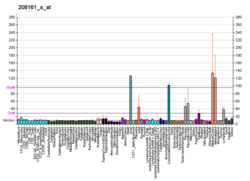Function
The protein encoded by this gene is a member of the superfamily of ATP-binding cassette (ABC) transporters. ABC proteins transport various molecules across extra- and intra-cellular membranes. ABC genes are divided into seven distinct subfamilies (ABC1, MDR/TAP, MRP, ALD, OABP, GCN20, White). This protein is a member of the MRP subfamily which is involved in multi-drug resistance. The specific function of this protein has not yet been determined; however, this protein may play a role in the transport of biliary and intestinal excretion of organic anions. Alternatively spliced variants which encode different protein isoforms have been described; however, not all variants have been fully characterized. [6]
ABCC3 is induced as a hepatoprotective response to a variety of pathologic liver conditions. The constitutive androstane receptor, pregnane X receptor and nuclear factor (erythroid-derived 2)-like 2 (Nrf2) transcription factors are involved in mediating induction. A functional antioxidant response element in the 8th intron of the human ABCC3 gene appears responsible for Nrf2-mediated induction in response to oxidative stress. [7]
This page is based on this
Wikipedia article Text is available under the
CC BY-SA 4.0 license; additional terms may apply.
Images, videos and audio are available under their respective licenses.




